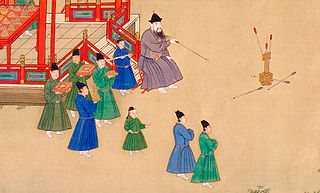Loading AI tools
Traditional Chinese game From Wikipedia, the free encyclopedia
Pitch-pot (simplified Chinese: 投壶; traditional Chinese: 投壺) is a traditional Chinese game that requires players to throw arrows or sticks from a set distance into a large, sometimes ornate, canister.
| Pitch-pot | |||||||||
|---|---|---|---|---|---|---|---|---|---|
 A Chinese (left) and Vietnamese (right) person participating in the traditional game of pitch-pot. | |||||||||
| Touhu | |||||||||
| Traditional Chinese | 投壺 | ||||||||
| Simplified Chinese | 投壶 | ||||||||
| |||||||||
| Tōko | |||||||||
| Kanji | 投壺 | ||||||||
| Kana | とうこ | ||||||||
| Tuho | |||||||||
| Hangul | 투호 / 투호놀이 | ||||||||
| Hanja | 投壺 / 投壺놀이 | ||||||||
| |||||||||
| đầu hồ | |||||||||
| Vietnamese alphabet | đầu hồ | ||||||||
| Chữ Hán | 投壺 | ||||||||
The game had originated by the Warring States period of China, probably invented by archers or soldiers as a pastime during idle periods.[1] The game began as a game of skill or a drinking game at parties, but by the time it was described in a chapter of the Chinese Classic Book of Rites, it had acquired Confucian moral overtones.[2] Initially popular among elites, it spread to other classes and remained popular in China until the end of the Qing dynasty. During this time it also spread to Korea, Japan and Vietnam.


In the Book of Rites,[3] it is written that "a pitcher is a ritual for the host to discuss his talents with his guests over a swallowed drink. The book also records the rules and methods of throwing bottles in the pre-Qin period. The rules and rituals of the game were elaborate, with the hosts and guests having to give way three times before the game could be played. The guests, including the attendants, are bound by the rules of etiquette.
Utensils[4]
Middle: scoring bucket.
Passage

Tuho appears to have come to Korea from China during the Goryeo period, in 1116 CE, and was popularised by King Yejong. The king's patronage made the previously banned game into a popular courtly pastime, until the influence of the Yuan dynasty once again diminished tuho's popularity.[5]
In the fifteenth century, the Joseon dynasty revived the game at court, promulgating it as a creation of Confucianism. It was defended from criticism by King Jungjong in 1518, who reaffirmed its respectability and its Confucian connotations. Popularity at court enabled the game to spread through the scholarly and lay community, although the Sarim scholars of the Late Joseon period dismissed it as frivolous. Despite this tuho was a favourite pastime of the scholar Yi Hwang, who recommended it to his students as a way to develop physical health and mental focus. Tuho was featured (along with Yi Hwang) on the 1000 won note from 1983 to 2002, but was left off of the newest version of the 1000 won note which was first issued January 22, 2007.[6] It was also recommended by Jeong Yak-yong, in his Mongmin Simseo ("Admonitions on Governing the People").[5]
Arrow vases sometimes feature in the sculptural imagery of norigae accessories, where they symbolise the rejection of bad fortune.[7][8]
Nowadays, the game is a traditional diversion on Korean New Year's Day and Chuseok. Modern versions are often played with a simple canister and rubber-tipped arrows. The arrows used are usually between 50 and 60 cm long, and are thrown at the arrow vase from around ten paces away.[9] Tuho was also a popular drinking game.[10] For every arrow that missed the pot, the loser or bulseung (불승/不承, lit. no-success) had to take a drink.[10] To prevent betting on the outcome, losers could opt to sing a song as a penalty instead.[10] Players who did not miss the canister were called hyeon (현, lit. wise).[10]
Seamless Wikipedia browsing. On steroids.
Every time you click a link to Wikipedia, Wiktionary or Wikiquote in your browser's search results, it will show the modern Wikiwand interface.
Wikiwand extension is a five stars, simple, with minimum permission required to keep your browsing private, safe and transparent.